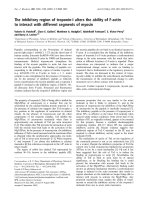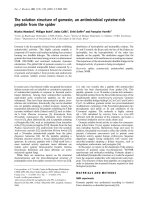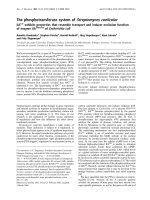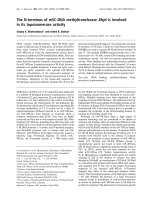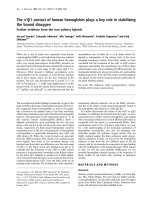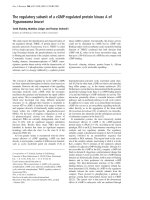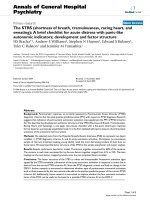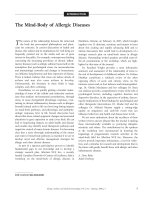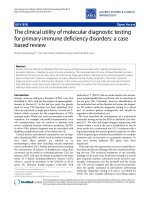Báo cáo y học: "The psychological well-being of children orphaned by AIDS in Cape Town, South Africa" pptx
Bạn đang xem bản rút gọn của tài liệu. Xem và tải ngay bản đầy đủ của tài liệu tại đây (280.97 KB, 9 trang )
BioMed Central
Page 1 of 9
(page number not for citation purposes)
Annals of General Psychiatry
Open Access
Primary research
The psychological well-being of children orphaned by AIDS in Cape
Town, South Africa
Lucie Cluver
1,2
and Frances Gardner*
1
Address:
1
Department of Social Policy and Social Work, University of Oxford, UK and
2
Cape Town Child Welfare, Gatesville, Cape Town, South
Africa
Email: Lucie Cluver - ; Frances Gardner* -
* Corresponding author
Abstract
Background: An estimated 2 million children are parentally bereaved by AIDS in South Africa.
Little is known about mental health outcomes for this group.
Methods: This study aimed to investigate mental health outcomes for urban children living in
deprived settlements in Cape Town. 30 orphaned children and 30 matched controls were
compared using standardised questionnaires (SDQ) on emotional and behavioural problems, peer
and attention difficulties, and prosocial behaviour. The orphan group completed a modified version
of a standardised questionnaire (IES-8), measuring Post-Traumatic Stress symptoms. Group
differences were tested using t-tests and Pearson's chi-square.
Results: Both groups scored highly for peer problems, emotional problems and total scores.
However, orphans were more likely to view themselves as having no good friends (p = .002), to
have marked concentration difficulties (p = .03), and to report frequent somatic symptoms (p =
.05), but were less likely to display anger through loss of temper (p = .03). Orphans were more
likely to have constant nightmares (p = .01), and 73% scored above the cut-off for Post-Traumatic
Stress Disorder.
Conclusion: Findings suggest important areas for larger-scale research for parentally-bereaved
children.
Background
An estimated 24.8% of South Africa's population are
HIV+, with 4.7 million infected by 2001 [1]. Numbers of
children parentally bereaved by AIDS in South Africa are
expected to rise from 1.1 million in 2003, to 3.1 million
by 2010 [2], peaking at 5.7 million in 2015. Even with the
proposed full administration of anti-retroviral therapy,
estimates remain at 1.15 million maternal orphans by
2015 [3].
Orphaned children in South Africa have traditionally
been cared for within the extended family [4], often by
elderly grandparents [5]. There are concerns that this sup-
port system is weakening as orphan numbers and HIV
prevalence increase [6]. There are few reliable data on
numbers of orphans living in non-kin fostering arrange-
ments, institutions, child-headed households and as
streetchildren [7].
Published: 19 July 2006
Annals of General Psychiatry 2006, 5:8 doi:10.1186/1744-859X-5-8
Received: 10 November 2005
Accepted: 19 July 2006
This article is available from: />© 2006 Cluver and Gardner; licensee BioMed Central Ltd.
This is an Open Access article distributed under the terms of the Creative Commons Attribution License ( />),
which permits unrestricted use, distribution, and reproduction in any medium, provided the original work is properly cited.
Annals of General Psychiatry 2006, 5:8 />Page 2 of 9
(page number not for citation purposes)
Most work on orphans concentrates on basic needs. This
is understandable as AIDS-affected households are charac-
terised by economic deprivation, often exacerbated by
medical costs [6]. Orphans frequently lack sufficient food,
shelter, schooling and medical care, and are at risk of
abuse and economic exploitation [8-10].
There is little available research, but increasing concern,
regarding the psychological well-being of orphans in
Africa. Children orphaned by AIDS are exposed to multi-
ple stressors which may compound and complicate the
grieving process. They may have cared for and witnessed
the death of parent/s with a debilitating illness, loss of
bodily functions, and sometimes AIDS-related mental ill-
ness [11,12]. AIDS can cause multiple losses, for example
of mother, father and perinatally-infected younger sib-
lings. Caregivers of orphans have been found to suffer
poor psychological health themselves [13,14]. South Afri-
can orphans report that stigma and secrecy surrounding
AIDS causes social isolation, bullying, shame, and a lack
of opportunity to openly discuss their loss [15]. Poor lev-
els of AIDS-related knowledge and communication can
lead to children being ignorant of the cause of death, or
fearing that they will also be infected [16].
Searches of literature on mental health for orphaned chil-
dren found 10 unpublished studies and 6 published stud-
ies to date. Of these, 6 lacked a control group and 9
compared children parentally bereaved by AIDS with
some kind of controls. There may be difficulties translat-
ing US studies to an African context, with differing sup-
port systems and characteristics of HIV-infected groups.
There is also danger in assuming that studies conducted in
one part of Africa are transferable to the South African
context. This is the first quantitative study known to be
completed in South Africa.
Studies in Africa
Sengendo and Nambi (1997) [17] interviewed 169
orphans under the education sponsorship of World
Vision in rural Uganda, and a comparison group of 24
non-orphans. On a non-standardised scale, orphans expe-
rienced more depression than non-orphans. Makame et
al. (2002) in urban Tanzania, used a scale based on the
Rand Inventory and items from the Beck Depression
inventory, and found increased internalising problems
and suicidal ideation in orphans (n = 41) compared with
non-orphans (n = 41). Manuel et al. [13] used a question-
naire based on Makame et al in rural Mozambique, and
found orphans (n = 76) more likely than controls (n = 74)
to be depressed and bullied, and less likely to have a
trusted adult or friend. Carers of orphans showed more
depression and less social support. Poulter (1996) inter-
viewed carers in 22 Zambian households with orphans,
66 with HIV+ parents, and 75 controls. On the Rutter
scales, carers reported orphans as more unhappy and wor-
ried than children with HIV+ parents, who were more so
than controls. No clear link was found between distress
and poverty, and there was no evidence of conduct prob-
lems [18]. Wild, Flisher, Laas and Robertson [19], in the
Eastern Cape of South Africa, used standardised question-
naires with orphans (n = 80) and both other-orphan and
non-orphan control groups, and found that children
orphaned by causes other than AIDS reported more
depression, anxiety and lower self-esteem than non-
orphans, with children orphaned by AIDS falling between
the two groups. In rural Uganda, Atwine, Cantor-Graae
and Banjunirwe [20], used standardised questionnaires
(Beck Youth Inventory) with 115 orphaned children and
110 matched non-orphaned children. Orphans had
greater risk of anxiety, depression and anger.
Two further, unpublished, studies found in Africa, were
unable to be accessed. A mention of Gelman [21], in Zim-
babwe, reports only the finding that existing Western psy-
chometric tools could not be validated. An interim report
of Elmore-Meegan et al (ongoing) in Kenya, describes a
multi-centre study using an adaptation of the Achenbach
CBCL. Preliminary results suggest more depression and
stress amongst orphans.
Non-controlled studies in Africa include Foster, Makufa,
Drew, Mashumba & Kambeu, (1997) in rural Zimbabwe.
In focus-groups, orphaned children (n = 40) reported anx-
iety, fear, stigmatisation, depression and stress. Nam-
panya-Serpell [22] used structured interviews with
families of rural and urban Zambian orphans, and found
emotional disturbance related to separation from siblings
and increased family size. Volle et al. [23] interviewed 788
orphans in Zambia. 89% reported unhappiness, and 19%
running away from their new homes. Makaya et al.
(2002), used clinical interviews with 354 Congolese
orphans, and found 20% experiencing psychological dif-
ficulties, including depression, anxiety and irritability
(34%), fugue, offending and hyperactivity (27%), and
PTSD (39%).
Studies in the USA
In New York, orphans (n = 30) reported more peer and
externalising problems on standardised instruments, than
children with HIV+ parents (n = 29) [24]. Another New
York study [25,26], using longitudinal assessments with
standardised instruments, found that bereaved children
reported more emotional distress and problem behav-
iours than children whose parents were alive and HIV+.
The Family Health Project [27,28] used standardised
instruments with 20 maternal orphans and 40 non-
orphans. Affected children were assessed pre-
orphanhood, and at 6 months after bereavement. Chil-
Annals of General Psychiatry 2006, 5:8 />Page 3 of 9
(page number not for citation purposes)
dren of HIV+ mothers showed more internalising and
externalising problems, and lower cognitive and social
competence than controls. 6 months after orphanhood,
there were non-significant improvements, and authors
suggested that this may be related to increased stability
and wealth amongst new caregivers. However, at 2 years,
orphans showed higher levels of internalising (but not
externalising) problems. Hirsch [29] compared 16 mater-
nal orphans by AIDS and 18 'other' orphans, and found
higher depression, anxiety and conduct problems, on
standardised scales, amongst children orphaned by means
other than AIDS.
The limited research suggests the possibility that orphans
may be experiencing higher levels of internalising and, to
a lesser extent, externalising problems. These studies,
combined with qualitative research on orphan well-being,
also hint at more specific areas of difficulty. Makaya
(2002) reported high levels of PTSD amongst Congolese
orphans, and studies have linked childhood PTSD to trau-
matic parental death, especially the witnessing of that
death [30-32] Orphans have reported difficulty concen-
trating at school, due to worries, sadness or tiredness
[27,33]. Concentration problems may be linked to post-
traumatic stress, as could anecdotal reports of recurrent
nightmares. Literature also suggests somatic symptoms
[34], which may be a useful indicator of distress amongst
children in South Africa [35]. Finally, friendship difficul-
ties related to stigma have been found in both qualitative
[9,33] and quantitative studies [13,36].
This study was conducted at the request of the Cape Town
Child Welfare Society. Little is known about the effects of
orphanhood in urban South Africa. Studies show multiple
stressors of violence and poverty common to all township
children, but there may be additional difficulties for
parentally bereaved children in these communities. Fur-
thermore, there is a clear need for further studies using
both matched non-affected control groups, and standard-
ised instruments, to test hypotheses suggested by the liter-
ature to date.
Hypothesis
We hypothesised that children who were orphaned by
AIDS would show a higher incidence of psychological dif-
ficulties than a non-orphaned control group from the
same community. Specific areas derived from the litera-
ture include difficulty with concentration, friendships,
traumatic and somatic symptoms.
Methods
Data collection took place in the Cape Flats around Cape
Town, South Africa, in both formal and 'informal' (shack-
based) settlements, between 2002 and 2003. Orphans
were compared with children who had not experienced a
parent dying of AIDS. The mental health of HIV+ children
is an important area of research, but this study focused on
children who were not known to be HIV+.
This study compares orphaned to non-orphaned children.
However, there is ongoing debate in South Africa around
these distinctions. In contexts such as social services and
financial provision, there are strong arguments for inter-
ventions targeting the wider group of 'Orphans and Vul-
nerable Children' [37] or universally targeting poor
children [38]. Whilst recognising the validity of these
arguments, it is equally important to have a secure evi-
dence base for understanding the effects of different fac-
tors on child mental health. This study aims to contribute
to an understanding of whether orphanhood by AIDS has
a psychological impact, compared to non-orphaned chil-
dren, within deprived communities.
Participants
The participants were 60 African children aged 6 to 19, liv-
ing in varying care arrangements, in the settlements of Old
Crossroads, Nyanga, Langa, Guguletu, Philippi, Blue
Downs and Browns Farm. Thirty controls were matched
by neighborhood, ethnicity, age and gender. Children
were recruited from a number of services, including the
Cape Town Child Welfare Society (children awaiting and
in foster placements), shelters for streetchildren and chil-
dren's homes. In order to access orphans who were not
receiving any welfare services, children were also recruited
through schools and community centres.
Procedure
Children were interviewed in their place of residence or
school. Privacy was maintained as much as possible,
although this was sometimes difficult in overcrowded
households. The research was conducted in the child's
first language, Xhosa or English. Questionnaires were
translated and blind back-translated. Blindness was par-
tially achieved for interviewers, who were unaware of
whether the child was an orphan until the final page of the
questionnaire. This contained the specific 'orphan' ques-
tions, and was blank for non-orphans. The questionnaire
took 15–20 minutes to complete.
Ethics
This is a highly sensitive area and care was taken not to
distress the children. Interviewers were Xhosa or English-
speaking social workers or careworkers trained in working
with children with HIV/AIDS. Due to low literacy levels,
information and consent leaflets were also discussed ver-
bally, and interviewers explained to children that they
could refuse to participate in the research at any point.
Following previous studies (Makame, 2002, Manuel,
2002, Poulter, 1996), HIV/AIDS was not mentioned in
Annals of General Psychiatry 2006, 5:8 />Page 4 of 9
(page number not for citation purposes)
research materials. Ethical approval was obtained from
Oxford University and Cape Town Child Welfare Society.
Measures
The Strengths and Difficulties Questionnaire [39], an
internationally well-validated screening tool for child
emotional and behavioral difficulties, was read aloud to
children. Additional questions addressed difficulties iden-
tified in earlier studies, including peer relationships, expe-
rience of violence, hunger and school attendance
(Makame et al. 2002; Manuel 2002) and demographic
questions. The orphan group only were given a brief ques-
tionnaire relating to PTSD-type symptoms, using items
from the shortened Impact of Events Scale (IES-8) [40].
Since the IES-8 requires that the child has experienced an
identified stressful event, and this was only available for
orphans, it was not given to the control group.
The SDQ includes subscales for prosocial behavior, hyper-
activity/attentional, emotional, conduct and peer prob-
lems. Scores >90th percentile predict substantially raised
probability of independently diagnosed psychiatric disor-
ders (Goodman 2001). The SDQ has been translated into
51 languages, and extensively validated in many Western
and developing countries (Mullick & Goodman, 2001),
but not in South Africa.
Stallard et al. [41] found the IES-8 to correctly identify
two-thirds of children with diagnosed PTSD and border-
line conditions. Smith et al. [42] compared the IES-8 used
in the UK with factor analysis of the IES-8 used in Bosnia,
and found the same structure of intrusion and avoidance,
with similar factor loadings for each item in both groups.
Although we could find no data for the use of IES-8 in
South Africa, a Bosnian study suggests that intrusion and
avoidance symptoms can be comparable for children in
different cultures. Following Winje and Ulvik [32], the
scaling of the IES was changed from a four-point scale (0–
1–3–5) to a three-point scale (0 = no degree, 1 = some
degree, 2 = high). Thus, the mean subscale scores in this
study should be prorated (× 2.5) to compare symptom
severity levels in other studies using the IES. Winje and
Ulvik report internal reliability of .72, intrusion, .75,
avoidance.
Analysis
Group comparisons used Pearson's χ
2
for categorical data,
and t-tests for comparing mean scale scores. Where litera-
ture strongly suggested that a particular item may differ
between groups, we analyzed individual items. Caution is
needed in analysing single items, and we attempted to
avoid multiple comparisons by only testing hypotheses
generated from the literature.
Results and discussion of results
Demographic factors
Table 1 shows no significant group differences on demo-
graphic questions. Almost half of all children went to bed
hungry 1 or more days per week. Most attended school
full-time (26 non-orphans and 23 orphans). Experience
of violence was similar, with slightly more non-orphans
reporting seeing or experiencing violence. Children
reported similar levels of 'trusted adults', although 17% of
children reported none.
Strengths and difficulties questionnaire (table 2)
Prosocial behavior
There were no differences between orphan and non-
orphan groups in total scores for pro-social behavior, or
for any individual questions.
Conduct problems
There were no group differences in total conduct problem
scores. One item showed a difference, namely that non-
orphans were more likely to report getting angry and los-
ing their temper than orphans (χ
2
6.8, p = .03). One of the
fears relating to the unknown psychosocial effects of
orphanhood in South Africa was the prospect of anti-
social behavior due to orphans 'raised without supervi-
sion' [43]. This presumption has been challenged [44],
and this study finds no evidence of increased self-reported
conduct problems amongst orphans.
Table 1: Demographic Factors
Orphans n = 30 Non-orphans n = 30 P value χ
2
Age Mean, (range) 11 (7–19) 12 (6–19) 0.42 7.2
SD 3.0 SD 2.8
Gender males 19 14 0.19 1.7
females 11 16
School Days attended Mean, (range) 4.3 (0–6) 4.8 (3–5) 0.30 7.2
Hunger Days hungry Mean, (range) 1.3 (0–7) 1.1 (0–7) 0.79 3.2
Trusted adult 'somewhat' or 'very true' 83% 83% 0.35 2.1
Violence 'somewhat' or 'very true' 44% 57% 0.12 4.3
Annals of General Psychiatry 2006, 5:8 />Page 5 of 9
(page number not for citation purposes)
Peer problems
There were no group differences in peer problems. How-
ever, only one orphan felt that they definitely had a good
friend (χ
2
9.4, p = .01). Orphans were more likely to per-
ceive themselves as not having any good friend (χ
2
9.4, p
= .02) (Table 3).
The lack of differences in overall peer problems is encour-
aging when compared to evidence of stigma and discrim-
ination affecting orphans [13,17,45]. However, the
difference in the single item 'I have one good friend or
more' shows that 97% of orphans perceived themselves as
having no close friend. It is possible that this reflects
stigma and myths around proximity to AIDS [33]. It may
also reflect PTSD-type symptoms such as detachment,
avoidance and difficulties in forming close relationships
[46]. An association was found for orphans between PTSD
'caseness' (cut-off score below/above 17) and endorse-
ment of the item 'children don't want to be friends with
me' (χ
2
6.1, p = .05). The high proportion of children who
met criteria for borderline or abnormal peer problems
(58%) suggest high levels of overall need in both orphans
and non-orphans.
Hyperactivity
There were no group differences in total hyperactivity
scores, with a slight trend towards non-orphans being
more hyperactive than orphans. However, orphans were
more likely to experience extreme difficulty in concentrat-
ing (i.e. endorsing this difficulty 'all the time') (χ
2
4.9, p =
.03) (Table 3). The overall scale suggests that other aspects
of hyperactivity are not seen as a problem by AIDS
orphans, and motor overactivity was not apparent from
anecdotal observation. It is possible that problems with
concentration are related to distress or Post-Traumatic
Stress Symptoms, rather than hyperactivity [47]. Other
studies have found concentration difficulties amongst
orphans [27,36,48] and lower educational achievement
[17,27].
Emotional problems
There were no group differences in overall emotional
problems. On the somatic item from the emotional scale,
orphans were more likely to report recurrent 'stomach-
aches, headaches or sickness' (χ
2
3.7, p = .05). The lack of
difference in the total emotional problems score may
indicate that orphans do not experience higher levels of
anxiety and depression than non-orphans. However, stud-
ies undertaken in the Cape Flats have found very high
overall levels of internalising distress amongst children in
general [49], and this may make it more difficult to isolate
sub-groups within this population.
Qualitative and clinical somatisation studies suggest that
the group difference on the somatic question might indi-
cate a way of expressing distress for orphaned children.
Another possible interpretation of the somatic item is that
these are not psychosomatic but actual illnesses, as studies
report insufficient medical care of orphans due to poverty,
discrimination and misattribution of illnesses to HIV
infection.
Post-Traumatic Stress
Questions relating to Post-Traumatic Stress were given
only to orphans. According to the protocol for IES-8,
PTSD questions were asked in relation to the death: 'how
you have felt about the death of your parent/s'. It is likely
that most children remembered the event, as their mean
age when orphaned was 8 years (SD 3.2) and mean dura-
tion of orphanhood was 3.5 years (SD 2.5).
PTSD 'caseness' in orphans
Using a cut-off score of 17 (found to correctly identify 47
of 49 UK children with a clinical diagnosis of PTSD; [50]),
73.3% of the orphan group fulfilled the criteria for suffer-
Table 3: Individual items from the SDQ whose importance was
suggested by earlier studies
Orphans Non-orphans P value χ
2
Extreme difficulty
concentrating
(n = 29) (n = 29)
10 (34%) 3 (10%) 0.03 4.9
Very frequent Nightmares (n = 30) (n = 30)
13 (45%) 4 (13%) 0.01 7.1
Definite lack of close
friendship
(n = 29) (n = 30)
29 (97%) 19 (66%) 0.002 9.4
Very frequent somatic
symptoms
(n = 30) (n = 30)
12 (40%) 5 (17%) 0.05 3.7
Table 2: Scores for Orphans and Non-Orphans on SDQ
Orphans n = 30 Mean, (SD) Non-orphans n = 30 Mean, (SD) P value t-test (2-tailed)
Pro-social total score 8.8 (1.9) 7.8 (2.2) 0.35 ns
Conduct problems total score 2.4 (1.9) 2.8 (2.2) 0.55 ns
Peer problems total score 3.5 (2.6) 4.2 (2.1) 0.28 ns
Hyperactivity total score 2.6 (2.0) 3.2 (1.4) 0.16 ns
Emotional problems total score 4.2 (2.7) 3.5 (2.4) 0.35 ns
Annals of General Psychiatry 2006, 5:8 />Page 6 of 9
(page number not for citation purposes)
ing from PTSD (figure 1). This is an extremely high level,
but it is important to be cautious in using 'caseness' defi-
nitions drawn largely from Western countries
One question on the PTSD scale was possible to incorpo-
rate into the questionnaire given to both orphans and
non-orphans : 'I have nightmares or sad dreams'. It is nor-
mal for children to experience some nightmares, but con-
stant and recurrent nightmares are one defining symptom
of PTSD (Yule, 2001). Within the groups, more orphans
(45%) than non-orphans (13%) suffered from night-
mares 'all the time' (χ
2
7.1, p = .01) (Table 3). The non-
orphan group did not answer PTSD questions, but the
group differences for the only shared question raises the
possibility that PTSD-type symptoms may be more com-
mon in orphans than non-orphans.
Correlates of PTSD
There were no differences in mean PTSD scores for boys
(26.5 SD 10.5) vs. girls (19.4 SD 12.8). There were no
associations between PTSD score and age of child (r = -
.05), or age of child when their parent died (r = 0.14) and
number of years the child had been orphaned (r = -0.15).
There was an association between PTSD scores and SDQ
emotional problems (p = .04).
General discussion
This study found no evidence of higher levels of self
reported emotional and behavioral problems in orphans,
using the SDQ. This must be understood within the con-
text of deprivation affecting both orphaned and non-
orphaned children in the urban settlements around Cape
Town. For example, both groups showed high levels of
exposure to violence and hunger. Norms established for
the SDQ [51] may be useful to indicate where there are
high levels of need, although caution must be used as
there are no SDQ norms available for Africa. However,
studies such as Fazel and Stein [52] have used British SDQ
norms to assess refugee children from multiple areas of
origin. When comparisons are made with British norms,
Distribution of pro-rated PTSD scores for orphansFigure 1
Distribution of pro-rated PTSD scores for orphans.
Annals of General Psychiatry 2006, 5:8 />Page 7 of 9
(page number not for citation purposes)
both the orphaned and non-orphaned groups showed
higher levels of difficulty in peer problems, emotional
problems and total SDQ scales (1–2, 0.5 and 0.5 SDs
higher, respectively). The orphan group showed 3× higher
'caseness' levels than British norms for peer problems.
Given the cautions raised about 'caseness', we might ten-
tatively suggest that there are high levels of some prob-
lems for orphaned and non-orphaned children living in
the deprived townships studied.
However, on some items suggested by earlier studies to be
particularly relevant to orphan mental health, there were
differences, including apparently high levels of PTSD-type
symptoms. Orphans were less likely than non-orphans to
have a good friend, more likely to have difficulty concen-
trating and to report somatic symptoms. There was no evi-
dence of conduct or behavioral problems amongst
orphans.
PTSD symptoms among orphans may be related to a
number of stressors. Death of a parent from AIDS could
be highly traumatic: the vast majority of AIDS victims in
South Africa remain at home, which are often informal
housing containing a whole extended family, and chil-
dren may perform roles of carers. For example, govern-
ment leaflets instruct on washing soiled bedclothes of
AIDS victims [53]. Thus many children witness the slow,
painful death of a parent in degrading circumstances. The
intermittent nature of the disease, stigma and secrecy
around the death, the move into foster care, into a child-
headed household, or onto the streets, could all poten-
tially contribute to trauma for children.
Conclusion
Limitations of the study
Limitations of the current study should be noted. This
research cannot show whether the problems identified are
related to orphanhood in general, rather than
orphanhood by HIV/AIDS. Future studies may need a
comparison group of children orphaned by reasons other
than AIDS. This design could be methodologically chal-
lenging in the urban South African context: cause of death
is frequently hard to ascertain and many reported non-
AIDS deaths are due to AIDS. In addition, further explora-
tion is needed of the traumatic effects of orphanhood due
to non-AIDS causes such as violent crime.
The most striking findings of this study are in the PTSD
scale, but this is the only part of the questionnaire which
was not also given to the control group of non-orphans.
However, the IES-8 scale requires an identifiable event
from which to measure intrusion and avoidance symp-
toms. There was no such easily identifiable event for the
non-orphan group, which would not have also been expe-
rienced by orphans. Surveys of PTSD amongst children in
the Cape Flats suggest high overall levels of symptoms
[54,55]. None of these studies have yet distinguished
between orphaned and non-orphaned children, and this
is an area which clearly requires further research.
Further limitations include the reliance on child self-
report of symptoms, and it is recognised that multiple
informants are preferable when assessing children [56].
However, we had serious methodological difficulties in
identifying and accessing suitable informants for many
children in the orphan group. These included children
who were living with new and unknown foster parents,
with unwell caregivers, in shelters for streetchildren, and
in child-headed households.
Blind back-translation of the questionnaire, information
and consent forms found the quality of the Xhosa version
to be good. However, the population studied was differ-
ent from those in which the scales used had been devel-
oped and standardised, therefore knowledge of reliability
and validity for this population is limited. Cross-cultural
measures of mental health always contain the possibility
of difference in meaning between researchers and partici-
pants. For example, it is possible that the measures of self-
reported depression in the SDQ were not ideally suited to
Xhosa culture. The single item analyses must be read with
caution, although all were generated from earlier litera-
ture. Moreover, cut-offs used for both the SDQ and PTSD
scales are problematic, although useful in indicating high
levels of need. These limitations mean that the findings
from this study should be treated cautiously.
Practical difficulties in this study included stigma and
secrecy around HIV/AIDS, which often delayed identifica-
tion of and access to affected families and children. High
levels of illiteracy, overcrowded dwellings and crime
resulted in non-ideal research settings.
However, the limitations of this study should be consid-
ered within the context of its strengths. This is the first
study in South Africa, and one of the first in Africa, to use
standardised questionnaires and a matched, non affected
control group in measuring psychological well-being of
children orphaned by AIDS. The findings suggest impor-
tant areas for larger-scale research into the mental health
of orphaned children. Despite the limited evidence, these
findings suggest that children orphaned by AIDS may
have unmet psychological needs. The finding of strikingly
high PTSD-type symptoms in this study indicate that this
should be a key area for research and intervention. Further
research is also needed to identify risk and protective fac-
tors for orphans, and into the effects of differing care
arrangements, as rising orphan numbers may lead to an
increase in child-headed households and streetchildren.
Annals of General Psychiatry 2006, 5:8 />Page 8 of 9
(page number not for citation purposes)
Currently, very few organisations provide psychosocial
support for children who are parentally bereaved by AIDS,
and only a small minority of children receive support. The
findings of this and other studies suggest that there is a
need for effective interventions to reach a larger propor-
tion of orphaned children. Such interventions must be
sensitive to the differing cultural norms and political
agendas around HIV/AIDS in South Africa. They must also
function within the scarce resources available in commu-
nities supporting orphans of the AIDS epidemic.
Competing interests
The author(s) declare that they have no competing inter-
ests.
Authors' contributions
LC carried out the fieldwork. FG and LC participated in
the design of the study, performed the statistical analysis
and drafted the manuscript. Both authors read and
approved the final manuscript.
Acknowledgements
The authors wish to thank the children who participated in the study, and
their families, Cape Town Child Welfare, the Homestead Shelter for
Streetchildren, Imbasa Primary School, and the General Social Care Coun-
cil (UK). Sources of support: Economic and Social Research Council (UK)
General Social Care Council (UK), University of Oxford.
References
1. Department of Health (South Africa): National HIV and Syphilis
sero-prevalence survey of women attending public ante-
natal clinics in South Africa 2001 - summary report. 2002.
2. UNAIDS, UNICEF, USAID, US Bureau of the Census: Children on
the Brink: a Joint Report on Orphan Estimates and Program
Strategies. UN; 2002.
3. Bradshaw D, Johnson L, Schneider H, Bourne D, Dorrington RE:
Orphans of the HIV/AIDS epidemic: The time to act is now.
Cape Town , Medical Research Council Policy Brief, no 2, May 2002;
2002.
4. Ankrah E: The impact of HIV/AIDS on the family and other
significant relationships. AIDS Care 1993, 5(1):5-22.
5. Foster G: Today's children: challenges to child health promo-
tion in countries with severe AIDS epidemics. AIDS Care 1998,
10:517-527.
6. UNAIDS, UNICEF, USAID: Children on the Brink 2004: A joint
report of new orphan estimates and a framework for action.
UN; 2004.
7. Townsend L, Dawes A: Willingness to care for children
orphaned by HIV/AIDS: A study of foster and adoptive par-
ents. African Journal of AIDS Research 2003, 3(1):69-80.
8. Berry L, Guthrie T: Rapid Assessment: The situation of chil-
dren in South Africa. The Children's Institute and Save the Chil-
dren; 2003.
9. ACESS: Children speak out on poverty: Report on the ACESS
Child Participation Process. Soul City, The Children's Institute,
University of Cape Town; 2002.
10. Giese S, Meintjies H, Croke R, Chamberlain R: Health and Social
Services to Address the Needs of Orphans and Other Vul-
nerable Children in the context of HIV/AIDS in South
Africa:Research Report and Recommendations. Cape Town ,
Children's Institute, University of Cape Town; 2003.
11. O'Olley B, Gxamza F, Seedat S, Theron H, Taljaard J, Reid E, Reuter
H, Stein DJ: Psychopathology and coping in recently diagnosed
HIV/AIDS patients - the role of gender. South African Medical
Journal (SAMJ) 2003, 93(12):928-931.
12. Tedstone J, Tarrier N: Posttraumatic stress disorder following
medical illness and treatment. Clinical Psychology Review 2003,
23:409-448.
13. Manuel P: Assessment of orphans and their caregivers' psy-
chological well-being in a rural community in central
Mozambique. London , Institute of Child Health; 2002.
14. Ferreira M, Keikelame MJ, Mosaval Y: Older women as carers to
children and grandchildren affected by AIDS: a study
towards supporting the carers. University of Cape Town, Insti-
tute of Ageing in Africa; 2001.
15. Bray R: Predicting the Social Consequences of Orphanhood in
South Africa. Centre for Social Science Research, University of
Cape Town; 2003.
16. Marcus T: Wo! Zaphela izingane - it is destroying the children
- living and dying with AIDS. KwaZulu Natal , University of Natal;
1999.
17. Sengendo J, Nambi J: The psychological effect of orphanhood: a
study of orphans in Rakai district. Health Transitions Review 1997,
7(Supplement):105-124.
18. Poulter C: Vulnerable Children: a Psychological Perspective.
The Nordic Africa Institute, AIDS Orphans of Africa Project; 1996.
19. Wild L, Flisher A, Laas S, Robertson B: The psychosocial adjust-
ment of adolescents orphaned in the context of HIV/AIDS.
Journal of child and Adolescent Mental Health, NISC. in press.
20. Atwine B, Cantor-Graae, Bajunirwe F: Psychological Distress
among AIDS orphans in rural Uganda. Social Science and Medi-
cine 2005:555-564.
21. Gelman S: Children growing up without parents - a study of
parental bereavement in the context of HIV/AIDS in Zimba-
bwe. In Clinical Psychology Tel Aviv , University of Tel Aviv; 2003.
22. Nampanya-Serpell N: Children orphaned by HIV/AIDS in Zam-
bia: risk factors from premature parental death and policy
implications. In Health Sciences Baltimore , University of Maryland;
1998.
23. Volle S, Tembo S, Boswell D, Bowsky S, Chiwele D, Chiwele R, Doll-
Manda K, Feinberg M, Kabore I: Psychosocial baseline survey of
orphans and vulnerable children in Zambia: Barcelona. ;
2002.
24. Draimin BH, Hudis J, Segura J: The mental health needs of well
adolescents in families with AIDS. New York , Human
Resources Administration; 1992.
25. Rotheram-Borus MJ, Lee M, Lin YY, Lester P: Six-Year Interven-
tion outcomes for adolescent children of parents with the
Human Immunodeficiency Virus. Arch Pediatr Adolesc Med 2004,
158:742-748.
26. Rotheram-Borus MJ, Stein JA, Lin YY: Impact of Parent death and
an Intervention on the adjustment of Adolescents whose
parents have HIV/AIDS. Journal of Consulting and Clinical Psychology
2001, 69(5):763-773.
27. Forehand R, Pelton J, Chance M, Armistead L, Morse E, Morse P,
Stock M: Orphans of the AIDS epidemic in the United States:
transition-related characteristics and psychosocial adjust-
ment at 6 months after mother's death. AIDS Care 1999,
6:715-722.
28. Pelton J, Forehand R: Orphans of the AIDS epidemic: an exam-
ination of clinical level problems of children. Journal of the
American Academy of Child and Adolescent Psychiatry 2005,
44(6):585-591.
29. Hirsch WM: A comparison between AIDS-orphaned children
and other-orphaned children on measures of attachment
security and disturbance. Dissertation Abstracts International 2001,
61(11-B):6137.
30. Black D, Harris-Hendricks K: Father kills mother: Post-Trau-
matic Stress Disorder in the children. Psychotherapy and Psycho-
somatics 1992, 57:152-157.
31. Stoppelbein L: Posttraumatic stress sypmtoms in Parentally
Bereaved Children and Adolescents. Journal of the American
Academy of Child and Adolescent Psychiatry 2000, Sept 2000:.
32. Winje D, Ulvik A: Long-term outcome of trauma in children:
the psychological consequences of a bus accident. Journal of
Child Psychology and Psychiatry 1998, 39(5):636-642.
33. Giese S, Meintjies H, Proudlock P: Workshop Report, National
Children's Forum on HIV/AIDS (2001). The Children's Insti-
tute, University of Cape Town; 2001.
34. Thomas K, Subotsky A, Almeleh C, Stratton L: Memory Box South
Africa: Manual. Cape Town , University of Cape Town; 2002.
Publish with BioMed Central and every
scientist can read your work free of charge
"BioMed Central will be the most significant development for
disseminating the results of biomedical research in our lifetime."
Sir Paul Nurse, Cancer Research UK
Your research papers will be:
available free of charge to the entire biomedical community
peer reviewed and published immediately upon acceptance
cited in PubMed and archived on PubMed Central
yours — you keep the copyright
Submit your manuscript here:
/>BioMedcentral
Annals of General Psychiatry 2006, 5:8 />Page 9 of 9
(page number not for citation purposes)
35. Swartz L: Culture and Mental Health: A Southern African
View. Oxford University Press South Africa; 2002.
36. Makame V, Ani C, McGregor S: Psychological well-being of
orphans in Dar El-Salaam, Tanzania. Acta Paediatrica 2002,
91:459-465.
37. Richter L: Slipping through the Safety Net. ChildrenFIRST 2001,
August/September(2001):30-33.
38. Meintjies H, Budlender D, Giese S, Johnson L: Children 'in need of
care' or in need of cash? Questioning social security provi-
sions to orphans in the context of the South African AIDS
pandemic. Cape Town , University of Cape Town, The Centre for
Actuarial Research, The Children's Institute; 2003.
39. Goodman R: The Strengths and Difficulties Questionnaire: A
research note. Journal of Child Psychology and Psychiatry and Allied Dis-
ciplines 1997, 38(5):581-586.
40. Dyregrov A, Yule W: Screening measures - the development of
the UNICEF screening battery.: May 7-11; Paris. 1995.
41. Stallard P, Velleman R, Baldwin S: Psychological Screening of chil-
dren for Post-Traumatic Stress Disorder. Journal of the Ameri-
can Academy of Child and Adolescent Psychiatry 1999, Sept 2000:.
42. Smith P, Perrin S, Dyregrov A, Yule W: Principal components
analysis of the Impact of Events Scale with children in war.
Personality and Individual Differences 2002, 34 (2003):315-322.
43. Schonteich M: The impact of HIV/AIDS on South Africa's
internal security. 2000.
44. Bray R: AIDS orphans and the future: a second look at our
predictions. Medical Research Council of South Africa, AIDS Bulletin
2004, 13(2):.
45. Foster G, Makufa C, Drew R, Mashumba S, Kambeu S: Perceptions
of children and community members concerning the cir-
cumstances of orphans in rural Zimbabwe. AIDS Care 1997,
10:391-405.
46. Carlson E, Ruzek J: Effects of Traumatic Experiences. [http://
www.ncptsd.org].
47. Yule W: Post-traumatic stress disorder in children and ado-
lescents. International Review of Psychiatry 2001, 13:194-200.
48. Makaya J, Mboussou F, Bansimba T, Ndinga H, Latifou S, Ambendet,
Puruehnce M: Assessment of psychological repurcussions of
AIDS next to 354 AIDS orphans in Brazzaville, 2001: Barce-
lona. ; 2002.
49. Robertson B, Ensink K, Parry C, Chalton D: Performance of the
Diagnostic Interview Schedule for Children Version 2.3
(DISC-2.3) in an informal settlement area in South Africa.
Journal of the American Academy of Child and Adolescent Psychiatry 1999,
38(9):1156-1164.
50. Yule W: Anxiety, depression and Post-Traumatic Stress in
childhood. In Child Psychology Portfolio Edited by: Sclare I. Windsor ,
NFER-Nelson; 1997.
51. Goodman R, Renfrew D, Mullick M: Predicting type of psychiatric
disorder from Strengths and Difficulties Questionnaire
(SDQ) scores in child mental health clinics in London and
Dhaka. European Child and Adolescent Psychiatry 2000, 9:129-134.
52. Fazel M, Stein A: Mental Health of Refugee Children: compar-
ative study. British Medical Journal 2003, 327:134.
53. Soul City: Caring for a person with HIV/AIDS. Jacana Education,
Departent of Social Development, South Africa; 2001.
54. Ensink K, Robertson B, Zissis C, Leger P: Post-traumatic stress
disorder in children exposed to violence. South African Medical
Journal (SAMJ) 1997, 87(11):1526-1530.
55. Heath K, Kaminer D: Types of Trauma exposure and severity
of PTSD sypmtoms amongst Langa Adolescents. In Depart-
ment of Psychology Cape Town , University of Cape Town; 2004.
56. Goodman R, Scott S: Child Psychiatry. Oxford , Blackwell Science;
1997.
